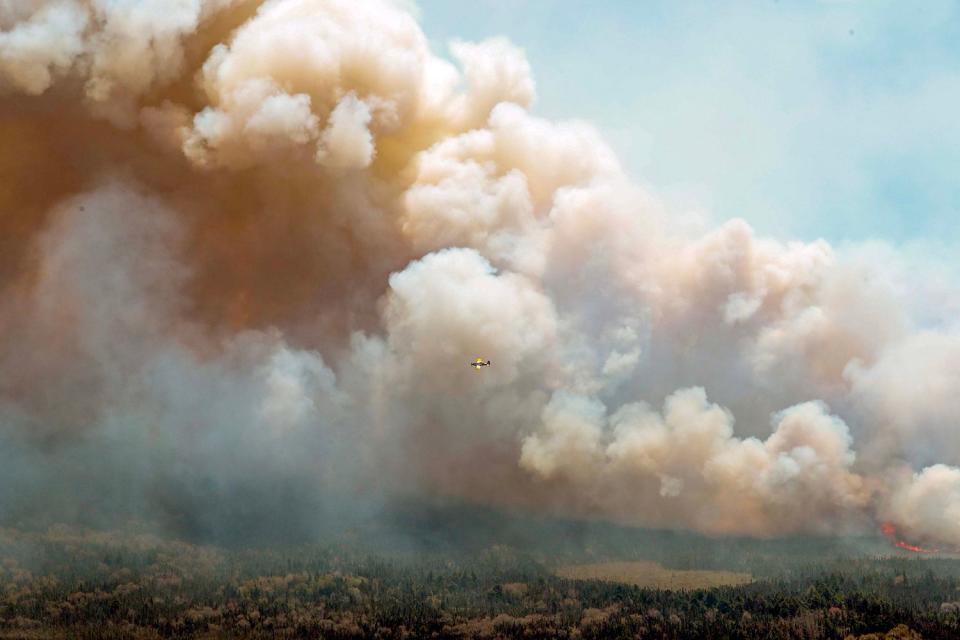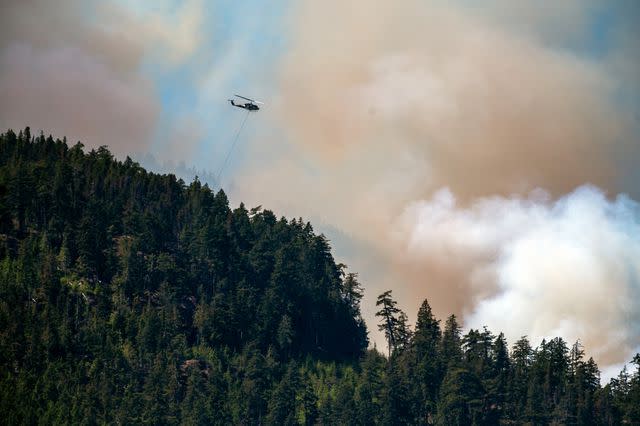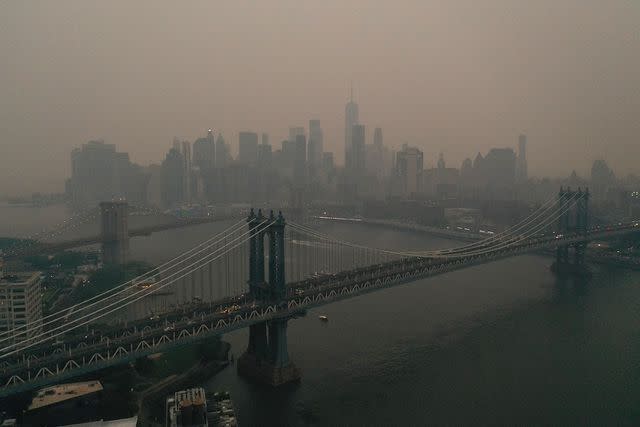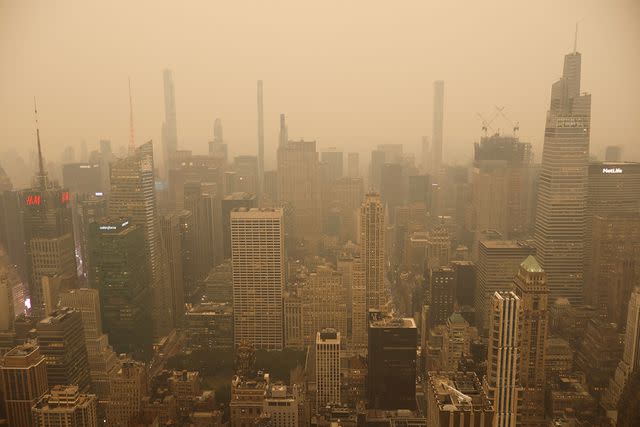All About the 2023 Central Canada Wildfires Affecting Parts of the United States
Between why they're happening and when they will end, here's what to know about the devastating Canadian wildfires

Xinhua/Shutterstock
Canada is experiencing some devastating wildfires, a shocking amount that's atypical from years past.
Based on official data, Reuters reported more than 3.3 million hectares (8.2 million acres) burned so far this year. According to officials, Canada is currently "on course for its worst-ever wildfire season on record."
United States’ northern neighbor is known for some of the world’s densest forests, so wildfires aren't anything new to the area since they've historically happened annually. But this year, the blaze is more intense than ever before, spreading wide and burning at an increased rate.
"This is a scary time for a lot of people," Prime Minister Justin Trudeau said at a news conference in Ottawa. Wildfires are Canada's second most expensive disaster (behind flooding) — negatively impacting oil and gas production, in addition to the destruction of homes.
Related: Why Is the Sun Red? All About the Air Quality Index and What It Means for Your Health
Air quality is also being affected, with plumes of smoke blanketing the skies and creating thick sheets of haze across the country. In recent weeks, the plumes have been so bad that parts of the United States have felt its effects.
Public health alerts have issued public health alerts in states ranging from New York to Minnesota, urging residents to stay indoors and wear masks to avoid inhaling potentially toxic fine particles in the air. New York City experienced the highest pollution level in the world on June 6.
The city's air quality index was labeled "very unhealthy" at over 200 per IQair, as CNN noted — the worst air quality of any major metropolitan city at 10 p.m. ET. The next morning, the Big Apple had slipped into third after Delhi, India topped the list, with Detroit coming in second.
Read on to learn more about the 2023 Canada wildfires, including why they are happening and how long they are expected to last.
Where are the 2023 Central Canada wildfires happening?

James MacDonald/Bloomberg via Getty
Wildfires are a common natural occurrence in Canada and have historically taken place around the same time each year. However, the annual fires have primarily blazed in the country's western provinces.
This year, the wildfires are more widespread, impacting the eastern provinces of Nova Scotia, Quebec and parts of Ontario. Also feeling the effects are British Columbia and Alberta, with government officials declaring a provincial state of emergency in the latter on May 6.
Quebec is Canada's biggest province by area, and as of June 5, was reportedly the "the worst impacted." As of June 6, Quebec was battling around 160 forest fires, displacing some 10,000 people, per Reuters. Ontario is the second-biggest by land area and largest by population, seeing a similar impact.
Related: Wildfires in Central Canada Create Air Quality Alert in Eastern U.S. (Live Updates)
What caused the wildfires in Central Canada?
Various factors can ignite a wildfire, typically starting with either lightning or human activity (like throwing a burning cigarette on the ground in a forest). The fires are most likely to catch when the ground is dry and the air is hot, which is why wildfire season typically lasts through summer.
Climate change also plays a role by causing high-pressure zones, which bring elongated periods of sunny, hot conditions and exacerbate drought. "The rash of blazes, intensified by record heat in many areas, is an ominous sign of the ill effects of climate change, which are not confined to Canada," per The Washington Post.
When did the 2023 Central Canada wildfires start?

Lokman Vural Elibol/Anadolu Agency via Getty Images
According to the Canadian Red Cross, most wildfires annually occur between April and September. This year, they began in late April in British Columbia and Alberta, and soon after, thousands have been forced to evacuate parts of the Nova Scotia region as wildfires raged east.
As of June 7, roughly 150 fires were active in Quebec alone, according to the Canadian Interagency Forest Fire Centre.
Are the 2023 Central Canada wildfires still active?
There are 423 active fires across Canada — 246 of them out of control, according to the Canadian Interagency Forest Fire Centre on June 7. Quebec still stands as the worst-affect province, with 154 fires recorded to date.
Alberta currently has 70 active fires, "which is at the highest level of preparedness," per The Washington Post. British Columbia has 68. According to the center's statistics, 20 of the 45 new wildland fires recorded on June 6 were in Ontario.
Due to the intensity of the fires and their out-of-control nature, parts of Canada have looked for international support for help. With more than 480 wilderness firefighters on the ground, Quebec can fight around 30 fires, Quebec Premier François Legault told reporters on June 5, adding that normally firefighters would come from other provinces to help.
“The situation remains serious,” Emergency Preparedness Minister Bill Blair said. “The images that we have seen so far this season are some of the most severe we have we have ever witnessed in Canada and the current forecast for the next few months indicates the potential for continued higher-than-normal fire activity.”
Legault said an additional 200 firefighters are coming from France and the United States, and Quebec is also in talks with Costa Rica, Portugal and Chile as it searches for additional resources, reported AP.
“With the given projections, it is expected that we have enough resources to cover the summer,” Prime Minister Justin Trudeau said. “If things get worse, we’re developing contingency plans.”
Related: New York City Recorded World’s Worst Air Pollution on Tuesday Thanks to Canada Wildfires Smoke
How are the 2023 Central Canada wildfires affecting the United States?

Gary Hershorn/Getty Images
According to the New York Times, a storm system swirling off the coast of Nova Scotia in recent days forced the smoke from these fires south into the United States, and then east — toward some of the most densely populated areas in the country.
New York City has an air quality alert in effect for the five boroughs as well as Long Island, the Hudson Valley and parts of Connecticut. Plus, a "red flag warning" has been issued for much of New Jersey because of an elevated fire risk.
Residents in the mid-west, stretching from Ohio Valley to as far south as the Carolinas, have also been impacted. Air quality advisories were put into effect on June 5 in southeastern Minnesota and parts of the Upper Peninsula of Michigan, as well as in more than 60 counties in Wisconsin.
While various states in the Midwest, mid-Atlantic and Northeast are currently being affected, be sure to check your local news outlets and listen to NOAA Weather Radio — per the National Weather Service's suggestion — to stay informed on the air quality in your area, while also learning how to stay healthy and safe as the fires continue to rage.
When are the 2023 Central Canada wildfires expected to end?
Due to the unpredictability of the wildfires, in part due to natural causes, it is hard to put a timeframe on their duration. However, Canadian government officials have created a plan amid the ongoing situation.
"Our modeling shows this may be an especially severe wildfire season throughout this summer," said Prime Minister Justin Trudeau, at a news conference. "This is a scary time for a lot of people, not just in Alberta, but right across the country, including in the Atlantic, the North and Quebec, too."
Despite the uncertainty, Trudeau said Canada should have sufficient resources to get through the summer. He mentioned the sign-off on aid requests from Alberta, Nova Scotia and Quebec. Plus, he agreed to sending Canadian Armed Forces troops.
"If things get worse, we are developing contingency plans and we will of course make sure that we are there, whether it's leaning more on international support, whether it's standing up other resources," Trudeau continued. "We will be there to ensure all Canadians are protected right through this summer."
For more People news, make sure to sign up for our newsletter!
Read the original article on People.

 Yahoo Sports
Yahoo Sports 